当前位置:网站首页>container
container
2022-04-23 05:56:00 【fattt_】
1、 Container and image
1. Analyze how the operating system manages processes ?
When we log into an operating system , We can go through ps(Process Statu) You can see all kinds of processes , Including the system's own 、 Or belonging to its own application 、 Or belonging to other applications .
So these What are the characteristics of the process Well ?
First, they can see each other , Mutual communication ; second , They use the same file system , This means that these processes can read and write to the same file ; Third , They use the same system resource .
This What problems will the three characteristics bring Well ?
First, they can see each other , Mutual communication , This means that processes with advanced permissions can attack other processes . second , They use the same file system , There are two problems :1. These processes can add, delete, modify and query the existing data , This means that the advanced permission process can delete the processes needed by other applications , Destroy the operation of other processes .2. The required dependencies between processes can lead to conflicts , This will put pressure on the operation and maintenance cost . Last , Because they use the same system resources , This means that there may be resource preemption between applications , When an application is very expensive CPU And memory , It will destroy the operation of other applications , It will cause other applications to fail to provide normal services .
How can we solve such a problem ? How to provide an independent running environment for these processes ?
The first question is for us , How to provide a separate file system ?Linux and Unix Provides a system called volume recording , It can change a subdirectory into a root directory , Of course, this is isolated at the view level , This means that this process can have an independent file system with the help of volume records , In this way, the addition, deletion, modification and query of the file system by this process will not affect the use of other processes .
second , Processes can see each other , Mutual communication , Even use the same network resources . In this case, we can use namespace Such a technology helps us isolate the process , That is, isolate on the view of resources . Record in volume and namespace With the help of the , This process can run in a separate environment .
Of course, in this independent environment , They still use the resources of the same operating system , That means it will still erode the resources of the whole system , In order to reduce its impact on other processes , We can go through cgroup To limit its resource utilization . such as , This process can only use 2G Memory , This process can only use 4 individual CPU wait . Record on volume 、namespace as well as cgroup With the help of the , We can provide a relatively independent environment for the process . In this way, processes will not affect each other .
So how do we define these process collections ?

2. What is a container ?
Containers , Is a view isolation 、 Resources can be limited 、 Process set of independent file system .
View isolation - If you can see part of the process , Independent host name, etc .
Control resource utilization - Such as 2G Memory size ,CPU Number of applications, etc .
3. What are the advantages of containers ?
It uses resources on the system , Therefore, this independent file system does not need to have kernel related code , Or tools . It only needs to provide the binary files and configuration files required by the container , Even dependence . As long as a container has all the files it needs to run , Then the container can run .
All the file sets needed to run the container are called Container mirror .
4. How to build a mirror ?
Usually , We will adopt Dockerfile To build a mirror image , Because it provides some convenient syntax pools to help us build a good image .
Dockerfile - Describe the steps to build the image :
Each build step adds files to the existing file system , Delete file , Even modify existing files . This will lead to changes in the file system , We call this change changeset.
We can see the following picture , This picture shows golang Mirror image , Each colored box represents the impact of each construction step and the construction steps 、 Description and so on . We will find that , When we apply the changes produced by these construction steps to an empty folder in turn , We can get a complete image . We can also find these changeset Reusable , The blue part of the picture below shows alpine Mirror image , The green part means golang Self change . You can find golang Image is based on alpine The image is built . In other words, images can be reused with each other .
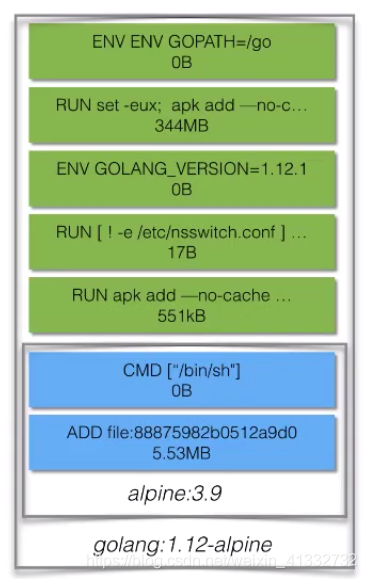
5. So these changeset Brought about by the Layering and reuse What advantages can the characteristics of bring ?
First of all , It can improve the efficiency of distribution . Let's simply imagine , For a large mirror , We split it into small pieces , We can improve the distribution efficiency , Because we can parallel down these data .
second , Because these data are shared with each other , That means when our local storage already contains these data , Then we just need to download some nonexistent data .
Third , Because these mirrored data are shared , It can save a lot of disk space .

6. How to build a mirror ?
First, let's see the following picture , This is a Dockerfile, Indicates how to build a golang Of application Of .
first line :FROM golang:1.12-alpine A mirror image , In other words, the following is based on golang Build , Images can be reused .
The second line : WORKDIR Indicates which specific directory the next construction steps will be carried out in , Be similar to cd operation
The third line :COPY Indicates that the files on the dataset can be copied into the container , Copy to the image .
Fourth 、 Five elements :RUN Indicates that the corresponding action is performed in a specific file system , such as go get Means download golang Program dependencies ,go install Said I would go build, Then move the generated binary to a searchable place , such as user\bin Below directory
When we're done , You can get one golang Of application.
Sixth elements :CMD When we use this image , Its default program name is app.

When we have such a Dockerfile after , We can use it docker build We can build what we need application. Of course, the result of this build is stored locally . In general , The image will be built in an isolated or other packaging environment .
that How does the image run in a production environment or a test environment ?
At this time, we need a transfer station , This transfer station is a central storage , We call this central storage docker registry, That is, image warehouse , It is responsible for storing all the image data we generate , We just need to pass docker push You can push the local image to the image warehouse , In this way, we can download the data in the production environment or test environment , And run it .

7. How to run a mirror ? That is, how to run a container ?
First step : Remove the corresponding image from the image warehouse , such as : download busybox Mirror image
docker pull busybox:1.25
The second step : View the local image list :
docker images
The third step : Select the appropriate image and run :
docker run [-d] --name demo busybox:1.25 top
analysis docker run Which parameters need to be specified ?
First , Give it a name , For example demo; then , What kind of image does this container use , That is to say busybox:1.25; the last one top Indicates that the process corresponding to this container is a top command .

8. Summary
An image is similar to a template , A container is like a concrete instance . Images are built once and run everywhere .
Containers : A collection of processes separated from other parts of the system .
Mirror image : A collection of all the files needed by the container -Build once, Run anywhere.
2、 The life cycle of the container
Single process model
(1)Init Process life cycle = Container life cycle
(2) During the operation period, it can run exec Perform O & M operations
Data persistence
(1) Container independent lifecycle
(2) Data volume - docker volume vs bind
Briefly review the previous section , A container is actually a set of collections with isolation characteristics , In the use of docker run You will choose an image as an independent file system when you are , And specify the corresponding running program , Then the running program we specify is called Init process .
When we use processes , You'll find this Init When the process starts , The container also starts , When this Init When the process exits , The container also exits . We can think of the container life cycle and Init The life cycle of a process is consistent . Of course, there is more than one container Init process ,Init The process will also have other child processes . Or through docker exec The generated operation and maintenance operations also belong to Init Within the scope of process management . When this Init When the process exits , Its child process also exits . This is to prevent the leakage of resources .
But what's the problem ?
First , An application may be a stateful , It may produce some very important data , for instance redis and MySQL wait . When a container exits , After being deleted , The data is also lost . This is unacceptable for data playback , So we need to persist the data generated in the container . that The container can persist to the specified directory , This directory is called data volume .
What are the characteristics of data volumes ?
It's pretty obvious The lifecycle of a data volume is independent of the lifecycle of the container , That is to say, the creation of containers 、 function 、 stop it 、 Deletion has nothing to do with the life cycle of the data volume , Because it is a special move, The help of data persistence is the container .
So what kind of use methods and characteristics do they have ? How do we use data volumes ?
Simply speaking , We'll put the data volume move Go into the container , In this way, the container can write the data to the corresponding directory , The exit of the container will not lead to the loss of data . And usually we have two ways : The first is bind The way , That is to put the directory on the dataset directly bind Go into the container , There is a drawback to this approach , It depends on the directory of the dataset , We need to manage the data set directory in a unified way ; The second way is similar to , Just leave the management of this directory to the running engine of the container , First, through docker create volume demo Create this data volume , The directory of this data volume is given to docker Managed , But the left part of this command becomes volume The name of , The other parts are the same as the first way .
We can find that data volumes exist independently of containers , It can help us to persist data quickly .
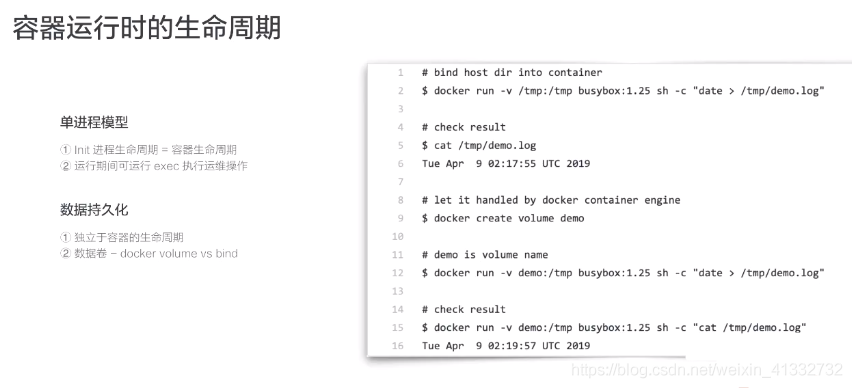
3、 The architecture of the container project
1.moby Container engine architecture
moby It is the most popular container management engine architecture at present .
moby deamon Provides information about containers for objects , Mirror image , Network and volume Management of . So what primary key does it rely on ?
The most important primary key it relies on is containerd,containerd Is a container runtime management engine , Independent of moby deamon Of , It can provide relevant management of container objects for objects .
But we will focus on the introduction of containers , We'll find that at the bottom of it is a place called containerd shim Such a module , This module is also a daemon , Why is it designed like this ?
First , It needs to manage the lifecycle of the container , Containers may be created by different container runtime , Because we now have many mainstream solutions of container virtualization technology , such as runC,kata,gVisor wait , Under the mainstream scheme of these different container runtime , We need to provide a flexible plug-in management , That is to say shim It is developed for different container runtime , So you can containerd Out of the middle , Manage through plug-ins . In addition, we can also see that the implementation of plug-in management can be implemented containerd Dynamic take over , It also has an important feature : It will not affect the operation of existing containers .
When we don't have this ability , Let's see what the consequences are ?
When moby deamon When I unexpectedly quit , No one manages the container , Then it will exit and disappear , This will also affect the operation of our application . Except for this case outside , We talk more often about moby upgrade , If we don't offer this shim The mechanism of , We will find that , We can't upgrade in place , So containerd shim The meaning of existence is very important , It implements a dynamic takeover capability .
This is it. moby Dissolve the architecture analysis of the management engine .
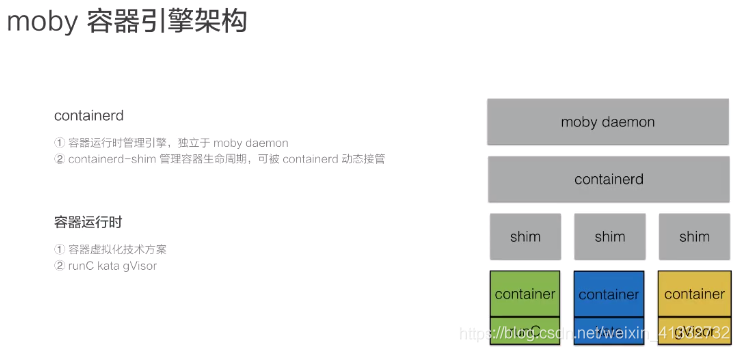
4、 Containers vsVM
1. Container and VM Differences between
What is? VM?
VM Is the use Hypevisor This virtualization technology simulates hardware resources , such as CPU、 Memory, etc , So we can build on the virtual machine Guest OS, That is what we often call building a virtual machine , every last Guest OS All have a separate kernel ,Ubuntu,CentOS,Windows wait , Each application is independent of each other , Because it's in a Guest OS I can't see anything else Guest OS Applications inside ,VM It can provide a better isolation effect , But this isolation effect also has a certain price . We need to hand over part of the computing resources to virtualization , In this way, it is difficult for us to make full use of the existing computing resources , And every one Guest OS Need to occupy a lot of sub disk space , Because each operating system may occupy a lot of sub disk space , for instance Windows Your installation may require 10-30G Space ,Ubuntu You may need to 5-6G Space , This will cause slow start-up , Consume a lot of resources , And occupy a lot of sub disk space , Such shortcomings give birth to container technology .
We know that containers are for processes , So it doesn't have to Guest OS, It only needs independent file technology , Provide the set of files it needs to run , All isolation is process level , So it starts faster than VM, And it consumes less disk space than VM. Of course, this process level isolation is not as good as expected , Its isolation effect is better than VM Much worse .
under these circumstances , Containers are also developing towards strong isolation .
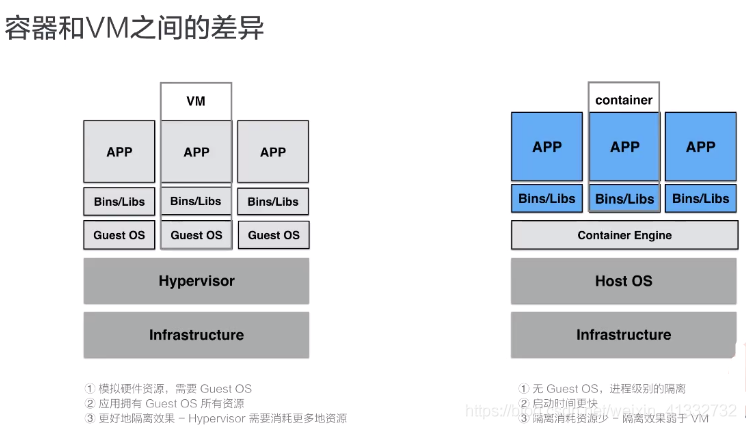
版权声明
本文为[fattt_]所创,转载请带上原文链接,感谢
https://yzsam.com/2022/04/202204230541585200.html
边栏推荐
- The attendance client date of K / 3 wise system can only be selected to 2019
- 创建企业邮箱账户命令
- 建表到页面完整实例演示—联表查询
- 2.devops-sonar安装
- 数字图像处理基础(冈萨雷斯)一
- Ptorch learning record (XIII): recurrent neural network
- Postfix变成垃圾邮件中转站后的补救
- 域内用户访问域外samba服务器用户名密码错误
- Pytorch學習記錄(十三):循環神經網絡((Recurrent Neural Network)
- Graphic numpy array matrix
猜你喜欢

Pyqy5 learning (4): qabstractbutton + qradiobutton + qcheckbox

你不能访问此共享文件夹,因为你组织的安全策略阻止未经身份验证的来宾访问
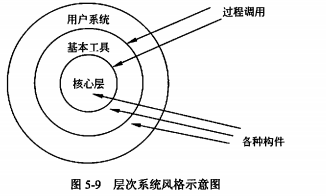
软件架构设计——软件架构风格

Dva中在effects中获取state的值

JVM series (3) -- memory allocation and recycling strategy

Font shape `OMX/cmex/m/n‘ in size <10.53937> not available (Font) size <10.95> substituted.

Pytorch learning record (XII): learning rate attenuation + regularization
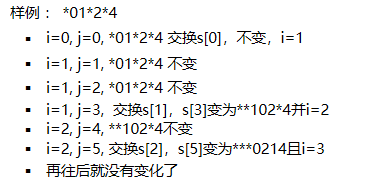
字符串(String)笔记
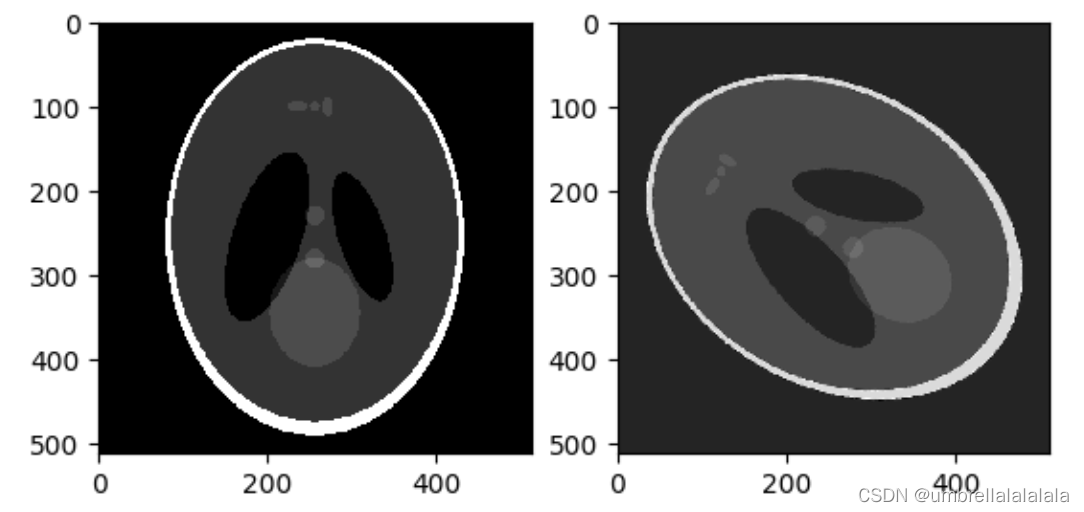
编程记录——图片旋转函数scipy.ndimage.rotate()的简单使用和效果观察

JDBC连接数据库
随机推荐
异常的处理:抓抛模型
软件架构设计——软件架构风格
线性规划问题中可行解,基本解和基本可行解有什么区别?
Latex quick start
MySQL transaction
Pytorch学习记录(十三):循环神经网络((Recurrent Neural Network)
字符串(String)笔记
实操—Nacos安装与配置
事实最终变量与最终变量
Pytorch学习记录(七):处理数据和训练模型的技巧
PreparedStatement防止SQL注入
PyQt5学习(一):布局管理+信号和槽关联+菜单栏与工具栏+打包资源包
建表到页面完整实例演示—联表查询
Meta annotation (annotation of annotation)
Pytorch learning record (IV): parameter initialization
Multithreading and high concurrency (1) -- basic knowledge of threads (implementation, common methods, state)
Write your own redistemplate
Solution record of slow access speed of SMB service in redhat6
Shansi Valley P290 polymorphism exercise
Understand the current commonly used encryption technology system (symmetric, asymmetric, information abstract, digital signature, digital certificate, public key system)